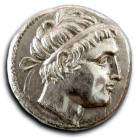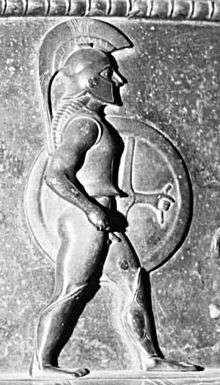Areus I

Areus I (Greek: Ἀρεύς Α΄) (died 265 BC) was Agiad King of Sparta from 309 to 265 BC, who died in battle near Corinth during the Chremonidean War. He was the grandson of Cleomenes II and was succeeded by his son Acrotatus II.
Military success
In 272 BC Areus I successfully repelled Pyrrhus of Epirus from Laconia. In 272 BC Pyrrhus of Epirus with 25,000 foot soldiers, 2,000 cavalry, and 24 elephants marched into Laconia on the false pretense of “set[ting] free the cities which were subject to Antigonus” and “to send his younger sons to Sparta, if nothing prevented, to be brought up in the Lacedaemonian customs”. While Areus was in Crete to support Gortys in its war against Knossos,[1] Pyrrhus set siege to Sparta. The men and women of Sparta dug a trench around the city to defend themselves against Pyrrhus' forces. After a day of fighting, the Spartans managed to hold back Pyrrhus from the large moat around the city. By the end of the second day of fighting, Areus had returned from Crete to Sparta with 2,000 soldiers, along with aid from Corinth which had just arrived.
Areus in the Maccabees
| “ | Areus king of the Lacedemonians to Onias the high priest, greeting: It is found in writing, that the Lacedemonians and Jews are brethren, and that they are of the stock of Abraham: Now therefore, since this is come to our knowledge, ye shall do well to write unto us of your prosperity. We do write back again to you, that your cattle and goods are ours, and ours are yours. | ” | |
| — Authorized King James Version 1 Maccabees 12.20 | |||
Three letters in the first book of Maccabees contain the Jewish claim to kinship with the Spartans. They are reproduced in a variant form by Josephus.[2]
References
Sources
- Plutarch, Lives: Pyrrhus xxvi–xxix
| Preceded by Cleomenes II |
Agiad King of Sparta 309–265 BC |
Succeeded by Acrotatus II |
